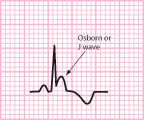Nejm 1994;331:1756; Postgrad Med 1990;88:55
Cause:Drowning, outdoor exposure, often associated with alcohol/drugs/overdoses, bacteremia in the aged, CVA, DKA, pancreatitis, hypothyroidism, hypoadrenalism
Pathophys:"Cold diuresis" occurs because of peripheral vasoconstriction and/or renal inability to resorb water. Hypoxic damage as hemoglobin dissociation curve shifted to left, releasing less O2 to tissues
Sx:Decreased cold perception
Si:Must use special thermometer, which can register <95°F (35°C)
Mild = 35°-32.2°C (95°-90°F); moderate = 32.2°-28°C (90°-82.4°F); severe = <28°C (82.4°F)
<95°F (35°C) causes ataxia, slowed reflexes, sinus bradycardia (don't do CPR as long as you can feel a pulse, even if it is very slow), hypotension; under 82.4°F (28°C) unconciousness occurs, fixed and dilated pupils
DIC within hours; ventricular fibrillation; hypoglycemia; hyperkalemia; frost bite; impaired drug clearance. Late cardiomyopathy due to multiple micro infarcts
Lab:
Chem:Screens for above causes; if K+ >2 × normal, universally fatal
Noninv:EKG shows Osborn J waves (wide, upright slur in terminal QRS; Figure 1.1) (Nejm 1994;330:680; Am J Physiol 1953;175:389) which are pathognomonic for hypothermia, occur at <80°F (27°C); general QRS widening follows and predicts ventricular fibrillation
Figure 1.1 Osborn waves seen in hypothermia

Reproduced with permission from Garcia T, Holtz N. The 12 Lead EKG, The Art of Interpretation. Sudbury, MA: Jones & Bartlett, 2001, p214
Rx:
(Med Let 1994;36:116)
Rewarm core 1st
if 85°-90°F (34°-36°C) and cardiovascularly stable, use warmed blankets, warmed D5S, and O2/air (104°F, 41.6°C)
if <85°F (<34°C) (Vfib risk) and/or unstable, then use warm lavages via Foley catheter, NG tubes, rectal tubes; intraperitoneal lavage (can raise by 2°C/h); pleural continuous warm lavage (Ann Emerg Med 1990;19:204) can raise by 20°C/h; or extracorporeal cardiopulmonary bypass, which is very effective (Nejm 1997;337:1500), consider transferring to get it
if in ventricular fibrillation or standstill, rewarm to 90°F before cardioverting or quitting; beware of impaired lidocaine metabolism
Antibiotics pending culture workup
Avoid heating blankets, which can rewarm periphery before core and cause shock and hyperkalemia although active rewarming of trunk alone may be ok
Avoid insulin for hyperglycemia since insulin resistance present at hypothermic temperatures but will act later, causing hypoglycemia
Of frostbite: severe, consider TPA locally infused (Nejm 2009;361:2654)
